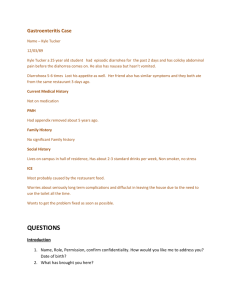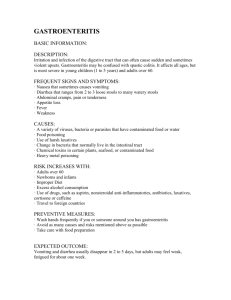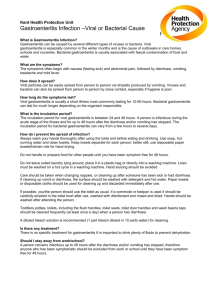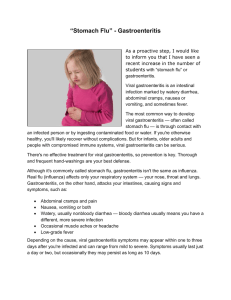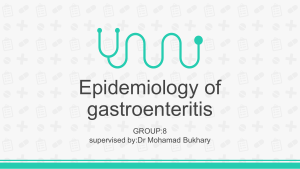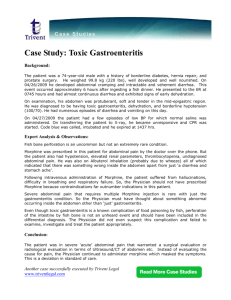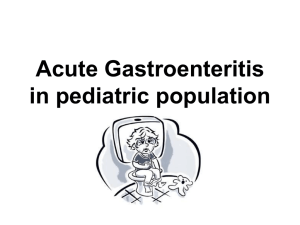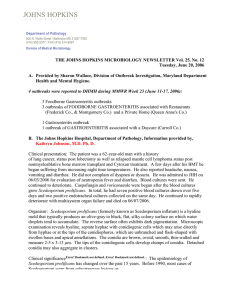Gastroenteritis In Primary School Children
advertisement
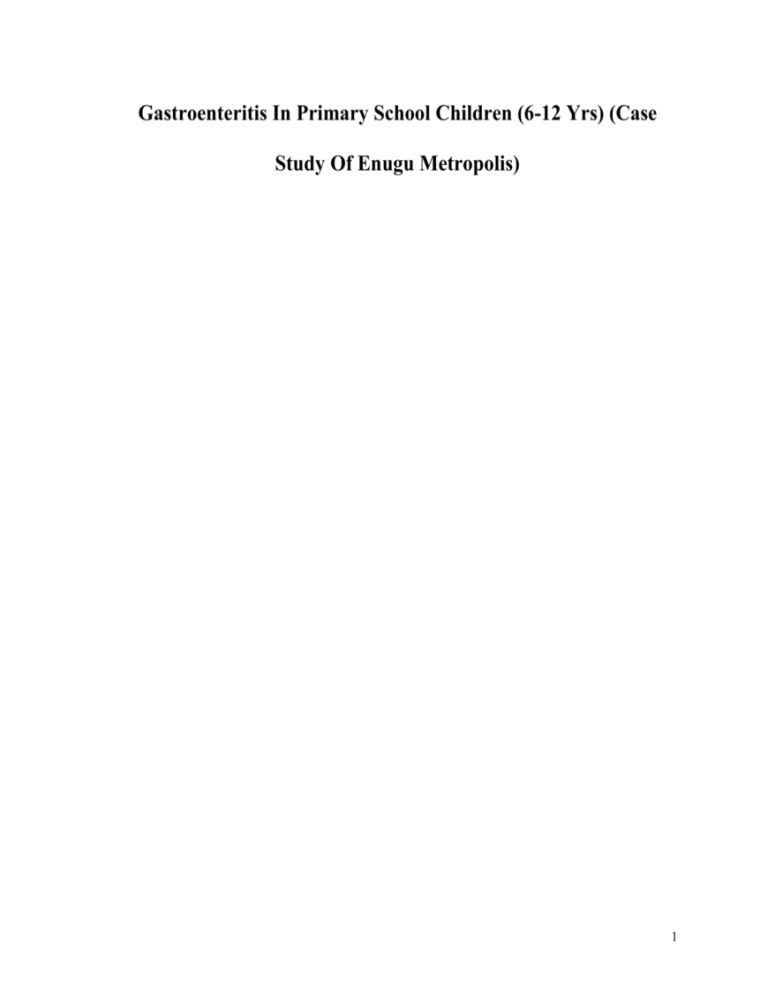
Gastroenteritis In Primary School Children (6-12 Yrs) (Case Study Of Enugu Metropolis) 1 2 TABLE OF CONTENT Title page Certification Dedication Acknowledgement Abstract List of table 1.0 CHAPTER ONE INTRODUUCTION 1.1 Aims and objectives 1.2 Statement of problem 1.3 Hypothesis 1.4 Scope/ limitations of study 2.0 CHAPTER TWO LITERATURE REVIEW 2.1 Environmental factor 3 2.2 Bacterial diseases of the lower alimentary system 2.3 Sources of infection 3.0 CHAPTER 3.1 material 3.2 Method 3.3 Method of culture 3.4 Plate reading 3.5 Biochemical reaction THREE MATERIALS AND METHODS CHAPTER FOUR RESULT CHAPTER FIVE – Discussion and conclusion CHAPTER SIX Reference Appendices 4 CHAPTER ONE INTRODUCTION Gastroenteritis is a disease condition due to the inflammation of the mucous of the stomach and intestine. Many microorganisms contaminating food and water can cause acute gastroenteritis. In most cases it runs its own course over several (days. However it can be a serious condition if the fluid loss is sever enough to cause dehydration. When food is the source of the pathogen the condition is often called food poisoning (Archeson 200) Gastroenteritis can arise in two ways the microorganisms may actually produce a food borne infection, that is, they may first colonize the gastrointestinal tract and grow within it, then either invade host tissues or secrete exo- toxins (Johnson, 1999). Alternatively the pathogens may secrete an exo- toxins that contaminates the food and is ingested by the host. This is some times reffered to as food intoxication because the toxins ingested and the presence of the living microorganisms is not required. Because theses toxins of the disrupt the 5 functioning of intestinal mucosa they are called enterotoxins (Sanders and sanders 1997) Most cases of gastroenteritis are due to viral infection about a half are caused by the rotavirus, first discovered and described at the royal children’s Hospital university of Melbourne in the early 1970 various other virus may cause the same symptoms as well as bacteria like campylobacter protozoa and helminthes. In most cases the precise infective agent is not identified. It is only when symptoms are persisting that stools are sent for microscopy and culture in the laboratory (Nachamkin 1992). On a global scale gastroenteritis is a massive health problem. About 5 million people die each year, mainly young children in underdevloped countries most deaths are due to dehgdration, in adequate fluid replacement and cirulatory collapse. In Australia, Asia, African and South America an occasional fatality still occurs with gastroenteritis again mainly due to complication of sever dehydration A rotavirus vaccine has been developed in Australia and may eventually have extensive world wide application (Prescott et al 2005). The main symptoms of gastroenteritis are vomiting diarliea and cramping abdominal pain. Sometimes of fever may also be present. In more severe cases, 6 signs of dehydration may appear a young child may look floppy and pale and the urine out put may be reduced. these signs means that urgent medical assessments and treatment are required. 1.1 AIMS AND OBJECTIVES - to determine the prevalenble of gastroenteritis in primary school children - also to implicate in gastroenteritis . - to relate the environment of the pupil to the types of diseases which they acquire from it. 1.2 STATEMENT OF PROBLEMS There are factors in the environment which iduce pior sanitation and the filthy habits of the children ideal for transmission of gastroenteritis, therefore infection rate is expected high. 7 1.3 HYPOTHESIS H0 - prevalence of gastroenteritis caused by bacteria and protozoa is common in primary school children H1 - Although environment favours infection prevalence is not common in primary school children . 1.4 SCOPE LIMITION OF STUDY - Limited to bacteria and protozoa involved in gastroenteritis as identifiable by the method used. Technology of viral identification is not feasible within the facities in this laboratory while helminthes parasite were excluded for case of control. 8 *** INSTRUCTIONS *** Please Read The Below Instructions Carefully. ****************************** HOW TO ORDER THIS COMPLETE MATERIAL If you want to order the complete materials (Chapter One to Five, Including Abstract, References, Questionnaires, Proposal (where applicable) ) of the above mentioned topic, please visit www.freeplace.org and click on “Order” (i.e. www.freeplace.org/order) ****************************** HOW TO BECOME OUR PARTNER To become our partner, visit www.freeplace.org and click on partnership. ****************************** TERMS OF USE This Material is for Academic Research Purposes only. On no account should you copy this material word for word. Copying this material “Word for Word” is against our “Terms of Use”. That you ordered this material shows you have agreed Our ‘Terms of Use’. ****************************** Better is not good enough, the best is yet to come! Endeavour to be the best!! 9
